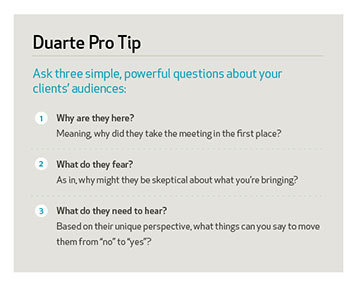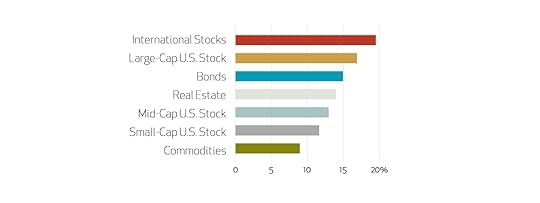Nancy Duarte's Blog, page 20
November 10, 2017
10 Ways to Interact With Audience Members While You Present
Presentation expert Clif Atkinson tells a great story about a 2009 education conference where two speakers got very different reactions from their audiences. The first speaker started off with interactive exercises, he was entertaining, and overall, he was a hit. The second speaker launched in with a more traditional powerpoint, and he… didn’t go over quite so well. [...] continue reading
The post 10 Ways to Interact With Audience Members While You Present appeared first on Duarte.
November 6, 2017
The Right Story at the Right Time: Motivate Your Team when They’re In a Slump
It’s an all-too-common scenario: you’re looking at your numbers, and you’ve finally realized that your team just isn’t performing well. Marketing leads are down, sales numbers are off, and customer satisfaction scores are flagging, too. This time, it’s not just a fluke or a blip caused by some outside factor that you can’t control. You’ve [...] continue reading
The post The Right Story at the Right Time: Motivate Your Team when They’re In a Slump appeared first on Duarte.
November 1, 2017
10 Ways to Interact With Audience Members While You Present

Presentation expert Clif Atkinson tells a great story about a 2009 education conference where two speakers got very different reactions from their audiences. The first speaker started off with interactive exercises, he was entertaining, and overall, he was a hit. The second speaker launched in with a more traditional powerpoint, and he… didn’t go over quite so well. In fact, while he presented, bored attendees started a “backchannel” on Twitter. They critiqued his slides, his content, and his delivery until finally, someone suggested a t-shirt. By the end of the keynote, you know exactly what happened: the t-shirt you see above was for sale on café press.
All this to say that audience participation isn’t necessarily a good thing. What you’re aiming for isn’t just participation for the sake of participation, but an interaction that gets the audience closer to embracing your ideas. You want to keep them engaged, on their toes, and show them that you value and want to connect with them. To that end, we offer you these 10 positive ways to interact with audience members to foster engagement and participation.
How to Interact With Audience Members During a Presentation
1. Ask a Series of “Raise Your Hand If…” Questions
The first simple thing to try is to ask your audience a series of questions. Each question should demand a gradually-more-difficult response throughout your presentation.
Within the first 60 seconds of a presentation, I like to ask the audience a simple question about themselves – then get them to respond by raising their hands. (“Raise your hand if you’ve ever…”) Why do this so early? A recent study on attention span during lectures showed that the first lapses in listener attention tend to happen within the first minute of the talk. So, by asking a question like this right away, you spark an interaction and establish a small, immediate connection.
If they’re willing to raise their hand at the beginning of a talk (and answer a poll, agree to a premise, etc.), they might be more willing to follow your call-to-action by the end of your presentation.
2. Tell a Joke
Another simple way that you can forge a connection at the beginning of your presentation is by telling a joke. A joke is, in itself, a smart way to interact with audience members since it’s a natural back and forth. It either asks the audience to answer a question (Why did the chicken cross the road?), or it elicits laughter (hopefully).
A 2017 study in the Journal of Personality and Social Psychology proved that using humor improves peoples’ perception of you in a professional setting. So try making your listeners laugh, and they’ll think even more highly of you from the get-go. (Note: joke-telling requires subtlety; get lots of feedback on your joke-telling abilities before trying it in front of an audience. Seriously! Telling a bad joke, or even a good joke badly, is a great way to lose your audience, too.)
3. Use a Polling Tool
Polls are one of the best ways to interact with audience members. They cause people to think critically about what they hear and urge them to share their own opinions and expertise. Aside from the typical hand-raising poll, technology can help here. Put a question on the screen, then ask people to respond via their smartphone or laptop. There are many polling tools out there that you can use to collect responses, including Polleverywhere.com, which is a popular app that can collect and broadcast poll results in real-time.
4. Turn to #Twitter
I’ve always been a fan of the power of Twitter to boost audience engagement during a presentation. Sure, it can be used to design a t-shirt about your boring talk. But better yet, you can use it to interact with audience members who are responding to your ideas in real time.
One of the simplest techniques is to create a unique hashtag for your talk. Ask them to send tweets with that hashtag. And make it easy for them by keepng your hashtag visible during your talk. You can even use a tool like EverWall to easily project what people are tweeting about your talk onto a screen in front of them.
Be strategic, though, about when and how often you display Tweets. You don’t want to distract people. Choose a strategic moment in the talk when you can step aside an let the opinions of the audience speak for themselves. Or, in a day packed with presentations, use Twitter in between talks to help boost audience interaction.
Displaying live content from Twitter works twice as hard other interaction techniques. It encourages listeners to grapple with what they’re hearing during a talk (and to wait and see their own tweet up on the stage) and tweeted content is available to the entire internet. This means that you can increase the reach of your event beyond just the people who are in the room.
5. Get the Slides in Peoples’ Hands
Presentation slides help you communicate your ideas clearly, but they can also get people to participate while you speak. Give people a closer look at slides by using a tool that can bring those slides directly into their hands. You can use a tool like Beamium, which lets people access your slides via their smartphones.
Another way to help people engage more with your slides is to simply invite them to snap a photo. Pause a moment, then say, “Okay, everyone, take out your smartphones. THIS is the slide you want to take home with you.” Not only do they get a nice visual takeaway, but you also get another moment to do a call-and-response with your audience.
6. Prop it Up
Physical, tangible props are another one of the easiest ways to interact with audience members while you present. You can use a prop onstage to demonstrate ideas, or you can pass it around the audience so that they can engage with it. Anything tangible increases the number of senses engaged and boosts your audience’s attention.
One example of a great speech that uses a prop is Jill Bolte Taylor’s “My Stroke of Insight,” in which Taylor used a human brain model as a prop to explain what happens during a stroke. Many props end up becoming a S.T.A.R. Moment, as well, which adds even more impact.
7. Get Active
The fact that you’re giving the talk doesn’t mean it has to be one-sided. You can get people to interact with activities. For instance, you can instruct audience members to pair off, then give them 5 minutes complete an exercise. This exercise could simply be an icebreaker to get to know someone else in the room. On the other hand, it could be an exercise that helps them develop useful skills you’re trying to impart (i.e. sales techniques, communication strategies, and more). Whatever you ask of them, just remember that each back-and-forth helps you work toward your big ask at the end.
8. Get People to Repeat Information Out Loud
It may seem like an elementary exercise, but if you want to be memorable and engaging, ask people to repeat key concepts out loud. In a study on memory, researchers at the University of Montreal found that repeating information boosts a person’s ability to recall that information. So, by asking your audience to repeat key facts and concepts from your talk, you increase the chances they remember it.
9. Take Questions Along the Way
Questions make it easy to interact with audience members, yes, but they can also help educate them about your information or idea. Don’t wait until after your talk or for when you can meet one-on-one with audience members to answer their questions. Designate times within your talk when you collect and answer questions from attendees. You can use a tool like Sli.do, which allows audience members to submit questions in real time. Then you can sort through those questions and answer the ones you deem best or most helpful.
This allows you to create more of a curated Q&A experience, instead of relying on strong, high-quality questions from your audience that also happen to reinforce your main message. Collecting them through an app this way allows you to have some quality control.
10. Create an Interactive Experience
You can take action a step further—with interaction. Your goal here is to make the audience feel like they are participating in something. Have them move around the room. When you create a space that doesn’t feel like an auditorium or physically interact with the audience, it feels like something is happening to them.
One great interactive talk I attended was about the effects of war on the availability of different spices in certain regions of the world. Stapled to the program for the show were two small plastic envelopes. In each envelope was a flavored marshmallow, labeled A and B. At the right moment in the presentation, the presenter asked everyone to eat marshmallow A, then compare it to the taste of marshmallow B. And in that moment, everyone in that room shared the same flavor experiences (and a moment of realization about one of the many indirect costs of war).
At the end of the day, your presentation audience is going to participate in your talk one way or another. You want to be sure to control the nature of that participation by being smart about the ways you interact with audience members while you present. You can directly engage them and dictate the things that they should be actively doing while you speak. If you try out some of the ways to interact with audience members discussed above, you can be pretty sure that no one will be bored enough to create a t-shirt about how boring you are. You may even end up with an audience who feels moved to make a t-shirt about how engaging you are – but who can’t do it because they are just so busy participating in your fascinating talk.
The post 10 Ways to Interact With Audience Members While You Present appeared first on Duarte.
October 31, 2017
The Right Story at the Right Time: Motivate Your Team When They’re In a Slump

It’s an all-too-common scenario: you’re looking at your numbers, and you’ve finally realized that your team just isn’t performing well. Marketing leads are down, sales numbers are off, and customer satisfaction scores are flagging, too.
This time, it’s not just a fluke or a blip caused by some outside factor that you can’t control. You’ve been tracking the pattern long enough to know that, this time, the problem is your team. Their mojo has gone AWOL.
When your team is in a slump, how can you, as their leader, help them get back on track? Sure, you can give them a clear goal to aspire to and help them build a plan to achieve it. But, if they’ve been struggling for a while, getting back on track might not come naturally to them. They may need you to give them reasons to believe they actually can win again.
That’s what the right story, told from a place of empathy, can do. Telling the right story at the right time can forge stronger bonds between you and your employees and inspire them to execute at the level you need.
But not all stories – even personal ones – work in all scenarios. Here are three things you can do to choose the right story for your situation.
Acknowledge their mood so you can plan how to move them.
If your team is going through a slump, fear not: all organizations go through seasons. Those seasons don’t just affect the bottom line, they also affect how people think and feel. During a time of poor performance, your team is likely feeling anxious, frightened, or mournful about the good old days. So, when choosing what story to deliver, consider not just how you’re feeling about your team’s poor performance – but also how it might be affecting their mood, too.

In Illuminate, my co-author Nancy Duarte and I explore when to use stories of different types – what we call motivating and warning stories – depending on the organizational mood. If your low-performing team members are acting complacent or seem unwilling to embrace change, you may need to use warning communication to chip away at their resistance. A warning story is one that cautions them about the possible negative outcomes of staying put or straying from the course. It can encourage them to face up to their challenge, or try out a different strategy. Picking the right story for the team’s mood can be the key to getting them moving or stopping them from heading in the wrong direction. 2. Think of your team as the heroes, not the villains.
2. Think of your team as the heroes, not the villains.
Your team is probably working hard, even if that effort isn’t completely paying off. So before you start preaching, put yourself in their shoes. Try hard to identify with what they’re experiencing and what’s difficult about their jobs. Then, let that guide you to tell a story that helps them see how they can be overcome their challenges and get to their goal. If your struggling team members can see or feel themselves in the stories you tell, they’ll relate more to you as a mentor — and be more motivated to apply the learning from your story.
A few years ago, I worked with an exec who was unhappy with her sales team’s performance. She wanted to motivate them to do better, so she planned to give a talk about her own early years in sales when it wasn’t uncommon for her to close three deals in a day. “It’s not that hard to sell,” she thought, and she believed her personal story about hustle and determination would get that point across.
However, that story could have landed the wrong way. It might have sounded like a brag or seemed like she was talking down to her team. It also may have made her look out of touch with what it takes to sell the company’s services today. It’s waaaayyy harder than it used to be – and her team knows it.
When she ran her story by me, we role-played how her team might react. She quickly realized it might backfire and decided to find a new story that would be more inspiring. She also realized her words needed to impart the heart of what actually makes a successful sale – which isn’t just hard work and hustle. After some thought, she chose to tell a tale about one sales rep on her team who was doing things right. This rep actually used to struggle to make quota, but he’d turned it around by practicing new skills, like researching his clients and competitors and using those insights to create targeted account plans and more relevant pitches. The new story landed well because it showed empathy for salespeople, and it communicated a point of view that revealed how her team could be more successful.

3. Give them something to think about — and something to do.
When people are flailing or failing, they tend to doubt themselves and start to question their decisions. So, giving your team clarity is really important – both in the actions that you expect and about the mindsets they should adopt. The better they understand what they should do – or not do – in the future to be successful, the more able they’ll be to take the right next step. That means your story needs to include a lesson of some kind.
Stories have long been used to communicate lessons, especially in the form of parables or fables. Ever since 600 BC, Aesop’s fables have been teaching people important life lessons like “slow and steady wins the race” or “look before you leap.”

Exploring the lesson that your own team needs to hear in this moment will point you toward the main point or “moral” of your story. The moral is like the story’s big idea. It asserts your unique point of view and illustrates the stakes if your audience does or doesn’t adopt it.
For instance, the executive who wanted to motivate her sales team first chose a story whose moral was simply “work harder.” But that was a bad takeaway for two reasons: it’s demotivating, and it’s vague. Instead, she realized that what she actually wanted to say was, “work smarter, and here’s how.” So she sharpened her message into a more specific – and motivating – moral: “By knowing your clients better, you can serve them better (and make your quota).” That lesson gave her team new knowledge they could use to approach sales from a fresher, and hopefully more fruitful, angle.
Ultimately, stories are a persuasive communication tool, but only if you choose the right one in each situation. If you want to move teams with your stories, it takes a little thought to understand your audience, find a story that’s relevant to them, and sharpen your takeaway so it elicits the outcome you want. If you approach the process with a clear outcome in mind and communicate with empathy, you can ensure that the stories you tell will resonate with your audience and advance your goals.
The post The Right Story at the Right Time: Motivate Your Team When They’re In a Slump appeared first on Duarte.
The Right Story at the Right Time: Motivate Your Team when They’re In a Slump.

It’s an all-too-common scenario: you’re looking at your numbers, and you’ve finally realized that your team just isn’t performing well. Marketing leads are down, sales numbers are off, and customer satisfaction scores are flagging, too.
This time, it’s not just a fluke or a blip caused by some outside factor that you can’t control. You’ve been tracking the pattern long enough to know that, this time, the problem is your team. Their mojo has gone AWOL.
When your team is in a slump, how can you, as their leader, help them get back on track? Sure, you can give them a clear goal to aspire to and help them build a plan to achieve it. But, if they’ve been struggling for a while, getting back on track might not come naturally to them. They may need you to give them reasons to believe they actually can win again.
That’s what the right story, told from a place of empathy, can do. Telling the right story at the right time can forge stronger bonds between you and your employees and inspire them to execute at the level you need.
But not all stories – even personal ones – work in all scenarios. Here are three things you can do to choose the right story for your situation.
Acknowledge their mood so you can plan how to move them.
If your team is going through a slump, fear not: all organizations go through seasons. Those seasons don’t just affect the bottom line, they also affect how people think and feel. During a time of poor performance, your team is likely feeling anxious, frightened, or mournful about the good old days. So, when choosing what story to deliver, consider not just how you’re feeling about your team’s poor performance – but also how it might be affecting their mood, too.

In Illuminate, my co-author Nancy Duarte and I explore when to use stories of different types – what we call motivating and warning stories – depending on the organizational mood. If your low-performing team members are acting complacent or seem unwilling to embrace change, you may need to use warning communication to chip away at their resistance. A warning story is one that cautions them about the possible negative outcomes of staying put or straying from the course. It can encourage them to face up to their challenge, or try out a different strategy. Picking the right story for the team’s mood can be the key to getting them moving or stopping them from heading in the wrong direction. 2. Think of your team as the heroes, not the villains.
2. Think of your team as the heroes, not the villains.
Your team is probably working hard, even if that effort isn’t completely paying off. So before you start preaching, put yourself in their shoes. Try hard to identify with what they’re experiencing and what’s difficult about their jobs. Then, let that guide you to tell a story that helps them see how they can be overcome their challenges and get to their goal. If your struggling team members can see or feel themselves in the stories you tell, they’ll relate more to you as a mentor — and be more motivated to apply the learning from your story.
A few years ago, I worked with an exec who was unhappy with her sales team’s performance. She wanted to motivate them to do better, so she planned to give a talk about her own early years in sales when it wasn’t uncommon for her to close three deals in a day. “It’s not that hard to sell,” she thought, and she believed her personal story about hustle and determination would get that point across.
However, that story could have landed the wrong way. It might have sounded like a brag or seemed like she was talking down to her team. It also may have made her look out of touch with what it takes to sell the company’s services today. It’s waaaayyy harder than it used to be – and her team knows it.
When she ran her story by me, we role-played how her team might react. She quickly realized it might backfire and decided to find a new story that would be more inspiring. She also realized her words needed to impart the heart of what actually makes a successful sale – which isn’t just hard work and hustle. After some thought, she chose to tell a tale about one sales rep on her team who was doing things right. This rep actually used to struggle to make quota, but he’d turned it around by practicing new skills, like researching his clients and competitors and using those insights to create targeted account plans and more relevant pitches. The new story landed well because it showed empathy for salespeople, and it communicated a point of view that revealed how her team could be more successful.

3. Give them something to think about — and something to do.
When people are flailing or failing, they tend to doubt themselves and start to question their decisions. So, giving your team clarity is really important – both in the actions that you expect and about the mindsets they should adopt. The better they understand what they should do – or not do – in the future to be successful, the more able they’ll be to take the right next step. That means your story needs to include a lesson of some kind.
Stories have long been used to communicate lessons, especially in the form of parables or fables. Ever since 600 BC, Aesop’s fables have been teaching people important life lessons like “slow and steady wins the race” or “look before you leap.”

Exploring the lesson that your own team needs to hear in this moment will point you toward the main point or “moral” of your story. The moral is like the story’s big idea. It asserts your unique point of view and illustrates the stakes if your audience does or doesn’t adopt it.
For instance, the executive who wanted to motivate her sales team first chose a story whose moral was simply “work harder.” But that was a bad takeaway for two reasons: it’s demotivating, and it’s vague. Instead, she realized that what she actually wanted to say was, “work smarter, and here’s how.” So she sharpened her message into a more specific – and motivating – moral: “By knowing your clients better, you can serve them better (and make your quota).” That lesson gave her team new knowledge they could use to approach sales from a fresher, and hopefully more fruitful, angle.
Ultimately, stories are a persuasive communication tool, but only if you choose the right one in each situation. If you want to move teams with your stories, it takes a little thought to understand your audience, find a story that’s relevant to them, and sharpen your takeaway so it elicits the outcome you want. If you approach the process with a clear outcome in mind and communicate with empathy, you can ensure that the stories you tell will resonate with your audience and advance your goals.
The post The Right Story at the Right Time: Motivate Your Team when They’re In a Slump. appeared first on Duarte.
Stuck in a Slump? Use Stories to Motivate a Low Performing Team
It’s an all-too-common scenario: you’re looking at your numbers, and you’ve finally realized that your team just isn’t performing well. Marketing leads are down, sales numbers are off, and customer satisfaction scores are flagging, too.
This time, it’s not just a fluke or a blip caused by some outside factor that you can’t control. You’ve been tracking the pattern long enough to know that, this time, the problem is your team. Their mojo has gone AWOL.
When your team is in a slump, how can you, as their leader, help them get back on track? Sure, you can give them a clear goal to aspire to and help them build a plan to achieve it. But, if they’ve been struggling for a while, getting back on track might not come naturally to them. They may need you to give them reasons to believe they actually can win again.
That’s what the right story, told from a place of empathy, can do. Telling the right story at the right time can forge stronger bonds between you and your employees and inspire them to execute at the level you need.
But not all stories – even personal ones – work in all scenarios. Here are three things you can do to choose the right story for your situation.
Acknowledge their mood so you can plan how to move them.
If your team is going through a slump, fear not: all organizations go through seasons. Those seasons don’t just affect the bottom line, they also affect how people think and feel. During a time of poor performance, your team is likely feeling anxious, frightened, or mournful about the good old days. So, when choosing what story to deliver, consider not just how you’re feeling about your team’s poor performance – but also how it might be affecting their mood, too.
In Illuminate, my co-author Nancy Duarte and I explore when to use stories of different types – what we call motivating and warning stories – depending on the organizational mood. If your low-performing team members are acting complacent or seem unwilling to embrace change, you may need to use warning communication to chip away at their resistance. A warning story is one that cautions them about the possible negative outcomes of staying put or straying from the course. It can encourage them to face up to their challenge, or try out a different strategy. Picking the right story for the team’s mood can be the key to getting them moving or stopping them from heading in the wrong direction.
Think of your team as the heroes, not the villains.
Your team is probably working hard, even if that effort isn’t completely paying off. So before you start preaching, put yourself in their shoes. Try hard to identify with what they’re experiencing and what’s difficult about their jobs. Then, let that guide you to tell a story that helps them see how they can be overcome their challenges and get to their goal. If your struggling team members can see or feel themselves in the stories you tell, they’ll relate more to you as a mentor — and be more motivated to apply the learning from your story.
A few years ago, I worked with an exec who was unhappy with her sales team’s performance. She wanted to motivate them to do better, so she planned to give a talk about her own early years in sales when it wasn’t uncommon for her to close three deals in a day. “It’s not that hard to sell,” she thought, and she believed her personal story about hustle and determination would get that point across.
However, that story could have landed the wrong way. It might have sounded like a brag or seemed like she was talking down to her team. It also may have made her look out of touch with what it takes to sell the company’s services today. It’s waaaayyy harder than it used to be – and her team knows it.
When she ran her story by me, we role-played how her team might react. She quickly realized it might backfire and decided to find a new story that would be more inspiring. She also realized her words needed to impart the heart of what actually makes a successful sale – which isn’t just hard work and hustle. After some thought, she chose to tell a tale about one sales rep on her team who was doing things right. This rep actually used to struggle to make quota, but he’d turned it around by practicing new skills, like researching his clients and competitors and using those insights to create targeted account plans and more relevant pitches. The new story landed well because it showed empathy for salespeople, and it communicated a point of view that revealed how her team could be more successful.
Give them something to think about — and something to do.
When people are flailing or failing, they tend to doubt themselves and start to question their decisions. So, giving your team clarity is really important – both in the actions that you expect and about the mindsets they should adopt. The better they understand what they should do – or not do – in the future to be successful, the more able they’ll be to take the right next step. That means your story needs to include a lesson of some kind.
Stories have long been used to communicate lessons, especially in the form of parables or fables. Ever since 600 BC, Aesop’s fables have been teaching people important life lessons like “slow and steady wins the race” or “look before you leap.”
Exploring the lesson that your own team needs to hear in this moment will point you toward the main point or “moral” of your story. The moral is like the story’s big idea. It asserts your unique point of view and illustrates the stakes if your audience does or doesn’t adopt it.
For instance, the executive who wanted to motivate her sales team first chose a story whose moral was simply “work harder.” But that was a bad takeaway for two reasons: it’s demotivating, and it’s vague. Instead, she realized that what she actually wanted to say was, “work smarter, and here’s how.” So she sharpened her message into a more specific – and motivating – moral: “By knowing your clients better, you can serve them better (and make your quota).” That lesson gave her team new knowledge they could use to approach sales from a fresher, and hopefully more fruitful, angle.
Ultimately, stories are a persuasive communication tool, but only if you choose the right one in each situation. If you want to move teams with your stories, it takes a little thought to understand your audience, find a story that’s relevant to them, and sharpen your takeaway so it elicits the outcome you want. If you approach the process with a clear outcome in mind and communicate with empathy, you can ensure that the stories you tell will resonate with your audience and advance your goals.
The post Stuck in a Slump? Use Stories to Motivate a Low Performing Team appeared first on Duarte.
October 26, 2017
3 Speaking Skills That Will Help You Communicate Data
Have you ever had lunch with a genius? And I don’t mean just someone really smart, but someone who lives and breathes their profession and can explain its mysteries with both passion and skill to anyone, regardless of education. I’ve met many geniuses like this in my life, and those conversations are some of my favorites. When we sit down and start talking, they come to life, relishing in my questions (even the dumb ones!) and bringing to life a complex subject so far outside my experience that sometimes I didn’t even know it existed. (I’m looking at you, quantum mechanics.) They tell me about DATA as though it is something alive and vital. They explain complex concepts as easily as I would explain basic math to a child.
I’m often amazed to find that these same people are capable of delivering a boring presentation. And yet they are; I’ve seen it! Something happens to them—whether it’s the shift from one audience member to many or the addition of a wireless lavalier microphone to their collar or the presence of slides or something else happening in the non-visible spectrum—they get boring.
Delivering complex data to an audience isn’t always easy. In fact, for many people, especially analytical types, it’s downright hard. In the public speaking workshops we offer at Duarte, we typically focus on increasing a speaker’s comfort, dynamism, and empathy in order to elevate their overall speaking skills. However, when it comes to the introverts and analytical types among us I’ve found that focusing on becoming more dynamic can be a very effective place to start.
To begin with, dynamism is an expansive quality that brings energy and power to the room. But being a more dynamic speaker can also help you capture an audience’s attention and reinforce your message. It’ll help you get through to your audience so that they don’t just leave with a head full of numbers, but rather with a heart bought into the story your numbers told.
The good news is that you likely already know the secret of dynamism. The secret of dynamic presentation is intentionality, the simple act of making a plan before you take the stage. Think about it, you’re methodical about your research, intentional about your slides… why shouldn’t the same principle apply to your stage presence? As you’re practicing your delivery, the question floating in the back of your mind should always be, “how can I be more purposeful with my movements and voice?” That intention should determine how you move on stage, what you do with your hands, and how you use your voice.
As we dive deeper into each of these techniques be sure to remember that there are no hard and fast rules about how to implement them… it all depends on who you are. Recognize your strengths and your natural speaking style and build upon it! A speaker coach or personalized workshop can be helpful to hone in on leveraging your strengths but to take the first steps, read on.
1. Make your Movements Matter:
When you step out onto a stage, your movements can either be a distraction or an asset. As opposed to wandering or standing stoically behind the podium, move purposefully. If you’re utilizing a timeline, walk across the stage and pause as the slides change, using your physical presence to mirror the markings on the screens.
A dynamic presenter recognizes that their movements also communicate a story—and that those movements should add, not subtract, from the main message.
Pro Tip: Take a video yourself giving your presentation then watch it on double speed or on mute. Are your movements taking away from, or adding to your performance?
2. Speak With Your Hands
Speech consultant Vanessa Van Edwards recently studied famous TED Talks. Contrary to what many of us may have learned in Toastmasters, hand motions might not be distractions after all. In her interview with The Washington Post, Van Edwards explains the talks, “that went viral and became wildly popular featured speakers who used their hands the most.” When the brain sees hand gestures in tandem with hearing a voice, she continues, “it’s getting two explanations in one.”
Imagine giving a physics presentation where you must explain the various parts of an atom. Instead of using words alone, your hands can add an entirely new dimension to the presentation.
Your hands are a part of the story and everything the audience is experiencing. In addition to using them to illustrate ideas, you can also move them carefully to underline key points, exaggerating movement before returning them to a neutral position.
A dynamic presenter uses their hands purposefully, adding another layer to their verbal communication.
Pro Tip: Plan at least five intentional hand movements you can add to your next presentation.
3. Vocalize Deliberately
Think about your favorite audiobook and the passages that kept you on the edge of your seat, the memorable quotes engraved on your mind, the dialogue that brought tears to your eyes. Like the narrator of that story, you have a similar obligation to your audience. Leverage the power of your voice to keep your guests entertained.
If your voice stays the same throughout your presentation, it’s challenging for your audience to know what’s important and what isn’t… and also to stay awake. Direct your audience’s attention to your main points with strategic pauses, variance in pitch, and speed of speech.
A dynamic presenter emphasizes critical points with their voice, “underlining” relevant information with their speech.
Public speaking is hard for anyone, but it can feel especially challenging for the analysts, researchers, and scientists tasked with communicating complex data and information to an audience. However, as it happens, those same people often make the best lunch companions—and they’re the people best suited to be dynamic presenters, they just don’t know it yet. Remember, the secret of dynamic presentation is intentionality. Instead of being afraid, approach your stage presence with the meticulousness you apply to your research.
Before you take the stage, take time to plan your movements and think about where you’re going to stand. Remember that your hands are part of the story, what are you going to make them say? Carefully review your slides and mentally note (or better yet, actually note) where to vocalize deliberately. Finally, remember it’s okay to get passionate! Part of being dynamic is letting your personality shine through.
Pro Tip: Before taking the stage, write out what inspires you about the content and taps into your passions.
Tell your story right—with all the same passion you bring to the work itself—and the audience will walk away with greater understanding.
The post 3 Speaking Skills That Will Help You Communicate Data appeared first on Duarte.
October 19, 2017
How to Display Data the Right Way in Presentations
It can be tricky to display data in presentations because different rules apply in different contexts. A sales director presenting financial projections to a group of field reps wouldn’t visualize her data the same way that a design consultant would in a written proposal to a potential client.
So how do you make the right choices for your situation? Before displaying your data, ask yourself these five questions:
1. Am I Presenting Or Circulating My Data?
Context plays a huge role in how best to render data. When delivering a presentation, show the conclusions you’ve drawn, not all the details that led you to those conclusions.
Because your slides will be up for only a few seconds, your audience will need to process them quickly. People won’t have time to chew on a lot of complex information, and they’re not likely to run up to the wall for a closer look at the numbers. So, think in broad strokes when you’re putting your charts together: What’s the overall trend you’re highlighting? What’s the most striking comparison you’re making? Those are the sorts of questions to answer when you want to display data in presentations.
Scales, grid lines, tick marks, and such should provide context, but without competing with the data. Use a light neutral color, such as gray, for these elements so they’ll recede into the background, and plot your data in a slightly stronger neutral color. Then use a bright color to emphasize the point you’re making, as in this example: 
It’s fine to display more detail in documents or in decks that you e-mail rather than present. Readers can study them at their own pace — examine the axes, the legends, the layers — and draw their own conclusions from your body of work. Still, you don’t want to overwhelm them, especially since they won’t have you there in person to explain what your main points are. Use white space, section heads, and a clear hierarchy of visual elements to help your readers navigate dense content and guide them to key pieces of data.
2. Am I Using The Right Kind of Chart or Table?
When you choose how to visualize your data, you’re deciding what type of relationship you want to emphasize. Take a look at this chart, which shows the breakdown of an investment portfolio:
In the pie, it’s clear that this person holds a number of investments in different areas — but that’s about all you see.
Here are the same data in a bar chart:
Now it’s much easier to discern how much is invested in each category. If your focus is on comparing categories, the bar chart is the better choice. A pie chart would be more useful if you were trying to make the point that a single investment made up a significant portion of the portfolio.
3. What Message Am I Trying To Convey?
Whether you’re presenting or circulating your charts, you need to highlight the most important items to ensure that your audience can follow your train of thought and focus on the right elements. For example, this chart is difficult to interpret because all the information is displayed with equal visual value:
Are we comparing regions? Quarters? Positive versus negative numbers? It’s difficult to determine what matters most. By adding color, you can draw the eye to specific areas:
We now know that we should be focusing on when and in which regions revenue dropped.
4. Do My Visuals Accurately Reflect The Numbers?
Using a lot of crazy colors, extra labels, and fancy effects won’t captivate an audience. That kind of visual clutter dilutes the information and can even misrepresent it. Consider this chart:
Can you figure out the northern territory’s revenue for year one? Is it 17? Or maybe 19? The way some programs create 3D charts would lead any rational person to think that the bar in question is well below 20. However, the data behind the chart actually says that bar represents 20.4 units. You can see that if you look at the chart in a very specific way, but it’s difficult to tell which way that should be — even with plenty of time to scrutinize it.
It’s much clearer if you simply flatten the chart: 5. Is My Data Memorable?
5. Is My Data Memorable?
Even if you’ve rendered your data clearly and accurately, it’s another challenge altogether to make the information stick. Consider using a meaningful visual metaphor to illustrate the scale of your numbers and cement the data in the minds of your audience members. A metaphor can also tie your insights to something that your audience already knows and cares about.
Author and activist Michael Pollan showed how much crude oil goes into making a McDonald’s Double Quarter Pounder with Cheese through a striking visual demonstration: He placed glasses on a table and filled them with oil to represent the amount of oil consumed during each stage of the production process. At the end, he took a taste of the oil to drive home his point. (To add an element of humor, he later revealed his prop “oil” to be chocolate syrup.) Watch the video here:
Pollan could have shown a chart, but this was more effective because he gave the audience a tangible visual — one that triggered a visceral response.
By answering these five questions as you’re laying out your data, you’ll visualize it in a way that helps people understand and engage with each point in your presentation, document, or deck. As a result, your audience will be more likely to adopt your overall message.
A version of this article originally appeared in HBR.
The post How to Display Data the Right Way in Presentations appeared first on Duarte.
September 21, 2017
This is What Presenters Can Learn From Dancing Scientists
From the time of Biblical David to the era of Kevin Bacon, people around the world have been dancing to celebrate, worship, entertain, and tell stories.
While “dance” nowadays may be predominately associated with “the Stars” or Channing Tatum’s abs, an original group of scientists is bringing the medium back to its storytelling origins.
A few years ago in Vienna, journalist John Bohannon spent New Year’s Eve with scientists of varying backgrounds. Like most of us trying to celebrate the last day of the year, he was worried the party would fall flat. His solution was to convince his friends to loosen up by explaining their work through a dance.
That evening, “Dance Your Ph.D.” was born.
Now, an annual competition, “Dance Your Ph.D.” challenges doctoral students across scientific disciplines to explain their theories, hypotheses, and research… without words. Science Magazine offers a monetary prize–and the adoration of academia–to Ph.D. candidates who can explain concepts like particle physics and heart valve biomedical engineering, through movement.
At Duarte, we’ve built a legacy around helping people and organizations distill complex information and make technical data digestible for a broad audience. We’ve used images, animations, motion graphics, even holograms, to try and bring a degree of visual clarity to our client’s work, but very honestly we hadn’t yet thought of using dance. We were inspired by their work and noticed how their strategies parallel some of our own, including:
Show and Tell:
When presenting, it’s “show-and-tell.” In fact, we often use visuals to drive the narrative and use only essential language on the presentation slides themselves. You can see this wonderfully illustrated in Uma Nagendra’s 2014 winning submission, “Plant-soil feedbacks after severe tornado damage.”
Almost all of Nagendra’s visuals were able to communicate highly technical, complex ideas, with few or no words.

A quick tip to remember when developing visuals for your presentations is the “3-second rule” – if the audience can’t ascertain the meaning of your ‘visual’ in less than 3 seconds, it needs revision. Try our Glance Test if you want to see how your slides stack-up. Fortunately, getting your meaning across can be easy if you have a solid Big Idea.
Isolate a Big Idea:
According to Nagendra, one of her key takeaways from the competition was learning how to “distill down to a core message without taking away from the complexity of the science itself.”
Right?!
To do this successfully, you have to define your Big Idea, or as Nagendra called it, your “core message.” This message then becomes the filter through which all ideas pass.
To distill the Big Idea behind your slides or presentation, Nancy Duarte recommends that you check that it:
 Articulates your unique point of view
Articulates your unique point of viewConveys what’s at stake
Can be described in one sentence
You can learn more about how to arrive at your Big Idea by checking out Duarte’s book, Resonate, or by taking one of our workshops. But, to start to arrive at the Big Idea that’s going to resonate with your audience, you have to first…
Understand the Audience:
To take the crown, the victor must successfully present to a panel of both scientists AND dancers. The champion is crowned on scientific merit and dancing ability, as well their ability to bridge the worlds of science and art. Participants in the contest didn’t just have to communicate with others within their specialty – they had to win over an audience that included members of an entirely different field!
Believe it or not the scientists’ experience in this context is similar to the experiences of some of our clients. In a corporate setting, we often present to people from various departments, backgrounds, and industries. That’s why we apply an audience-centric lens to our work as soon as we start to think about a presentation.
When you begin to prepare your presentation, always consider where your audience is now, what they understand, and what they’re predisposed to believe. Then, imagine what you want them to understand and believe when you’re done presenting. That’s your audience’s journey. Everything in your presentation should be in service of moving them along that path.
But if you want to communicate with an outside audience, you’d better…
Drop the Jargon:
Technology and science are evolving at warp speed and with the breakthroughs comes a new vocabulary. The issue is, it’s unlikely those outside of your field are familiar with your professional slang. You need to modify your language (or, in the Ph.D.’s case remove it all together) to help the layman understand what you’re saying. Ultimately, your idea’s perceived value will be largely based on how well you can communicate it.
Like successful presenters, to succeed in the contest, the PhDs had to show more than they told. While their research was technical, they had to remember the diversity of their audience, “kill their darlings” and stick to the “Big Idea.” Finally, in the case of the scientists, they didn’t just drop jargon, they dropped language altogether and returned to the universal language of movement. While that may be impractical for the boardroom, the lesson here is to modify your language to resonate with everyone in the room.
So, next time you’re explaining quantum mechanics, compelling organizational change, or just trying to convince a small town to let you dance… our new scientific friends have taught us: a beat is worth a thousand words.
The post This is What Presenters Can Learn From Dancing Scientists appeared first on Duarte.
September 5, 2017
6 Powerful Pitch Deck Tips to Get Seed Funding
Congratulations on having a great business idea. Extra congratulations if you’ve started the company and gotten some traction. Good job, you! Now all you need is some money to bring your startup vision to life. So…you start writing a pitch. You’ve generated solid research and big ideas – but now you have to distill and communicate your plan for investors to see the full potential.
Enter: the pitch deck. Perhaps the most important powerpoint you’ll ever create: 10-20 slides of solid persuasion.
A pitch has a similar end goal to any persuasive presentation: convince listeners to adopt an idea and take an action. However, there are some factors that make crafting a pitch deck its very own unique beast, not least of all the challenge of hooking the attention of busy investors who hear startup pitches all day long.
If you want to be a diamond in the rough, get ready to make a pitch deck that is clear, succinct, and impossible to forget. To do so, keep in mind these powerful tips.
1. Your deck is your sidekick, not your teleprompter.
Your deck is not your script. That’s one of the deadliest sins of presenting. Slides are there to support you, to amplify
your voice. And, your pitch should come so naturally that you don’t even need slides. Focus on design that distills your most important numbers and facts.
Speaking of slide simplicity, your audience can’t listen to you and read at the same time. The key is to keep your slides simple, with each communicating just one idea. If that means more slides, so be it! No need to handcuff yourself to an arbitrary slide count, as long as your ideas are clear and direct. Apply the three second rule, which we hold so dear at Duarte: can someone understand the point of your slide in three seconds? If not, simplify it.
2. Do the work to know your audience.

Everyone you’ll ever pitch to has a different angle on you and your story. They have different goals and fears themselves. So, it’s your job to understand them well enough before you make a pitch deck to tap into their desires and unique strain of FOMO. According to NextView Ventures, an ad tech startup might have to contact 37 VCs before they get their Series A funding, so you have to be prepared to tune your deck for each audience.
Think about it this way: Investor X has never invested in your industry. Investor Y has been burned by a business like yours. Investor Z is known to cut people off 3 minutes into a pitch. How does that impact your flow, your tone, and the points to emphasize most?
Your presentation can’t be a rigid, locked document. It has to be living and breathing.
Slides have to move around depending on the audience. We call that a modular presentation. Building a deck that can withstand iterations will save you time and energy. Bottom line: your audience is the hero, tell them a story they want to hear.
3. Start at the heart — then build the skeleton.

If you had two sentences, ten words each, to sell someone your idea, what would you say? We encourage all presenters to hone in on that big idea before even opening PowerPoint. What are you doing and how is it going to succeed? When you make a pitch deck, devote your entire presentation to that central concept.
Try it. Two sentences. Ten words. Like this: “BalloonZoom is a luxury commuter service in the sky. With 100K rides in 1 month, we’re ready for growth.”
You told me what you do and why things are looking up. No fluff, no hand waving. If you can get to the heart right of your pitch right away, you will be able to hook their attention and hold their ear. Sure, you have a lot more to say about the massive problem you’re solving, the starved market you’re serving, and your strategies for making money, but at least I’m leaning in now.
Here is an example:

4. Bring it home.
A pitch deck’s strong introduction will capture the audience’s attention but don’t forget to create a killer conclusion.
A pitch deck with a confident conclusion will remain on the mind of your audience well after you leave the room and will help you stay in control until the very end.
When you make a pitch deck, invest time in thinking about how you’ll end to pack a punch, and get creative.
Try this formula: call to action + bold sign-off. Your call to action is your chance to guide them towards what you want – a check to fund your startup idea, another conversation. What do you want now?
A bold sign-off is the thing they’ll remember when you leave. Maybe it’s an exciting phrase that’s also captured on the last slide. Maybe it’s an emotive photo while you encourage them to picture a world free from the problem you’re solving. Maybe it’s reminding them that you, as a leader, are totally committed to success. Either way, plan for a succinct and exciting ending.

5. Play the role of sophisticated Sherpa.
If your audience is the hero on a journey, you are their guide. Their Sherpa. Your job is to enlighten, not overwhelm. To do that, organize and serve up information thoughtfully. Many startup investor decks flow like run-on paragraphs—with no clear breaks. Bad idea. A rapid info dump makes it hard for them to retain and understand information. You force them up the hill too fast, with no time to catch their breath or process the experience.
A good presenter feeds information to their audience bit by bit, breaking it down into logical chunks, and building a case methodically. When you make a pitch deck, think of the chapters in a book, then use your words and your visuals to help guide the audience along through the narrative.
6. It’s an investor deck, not a commercial.
Does your deck say, “We’re really onto something that will make you a lot of money”? Or, “We have pretty colors and our customers dig it”? Even if you’ve spent time on your brand and picking just the right colors and aesthetic, keep in mind a pitch deck is for investors and business-focused people, not for your customers or recruits. When beginning your pitch deck design, consider whether your brand ethos really enhances the investor story.
Here’s an example of when branding doesn’t serve a pitch deck: a female-run company wants money for their innovative newborn baby swaddler, so they craft a deck full of soft language and a gentle aesthetic. But – let’s face it: most investors aren’t drawn to gentle and soft, and potentially – weak. Instead, that company should dial down their brand’s tone (which doesn’t serve them in this situation) in favor of a more hard-hitting business voice, supported by their impressive numbers.
Building a brand identity as a startup is exciting and important in the long run – but if there’s one moment you should let it take a back seat – this is it.
Delivering a pitch deck to a group of investors is a high-stakes moment — one of a slew that you’ll encounter as you launch a business venture. Luckily, you can nail that high stakes moment easily if you just have the right tools in your arsenal, like a great pitch with a well-designed deck to go along with it. In the long run, nothing will replace your ability to lead as you venture into new territory– however, being equipped to do things like delivering persuasive stories that change minds or sell convincing data to influence decisions is an asset that will ultimately take you a long way.
The post 6 Powerful Pitch Deck Tips to Get Seed Funding appeared first on Duarte.



























